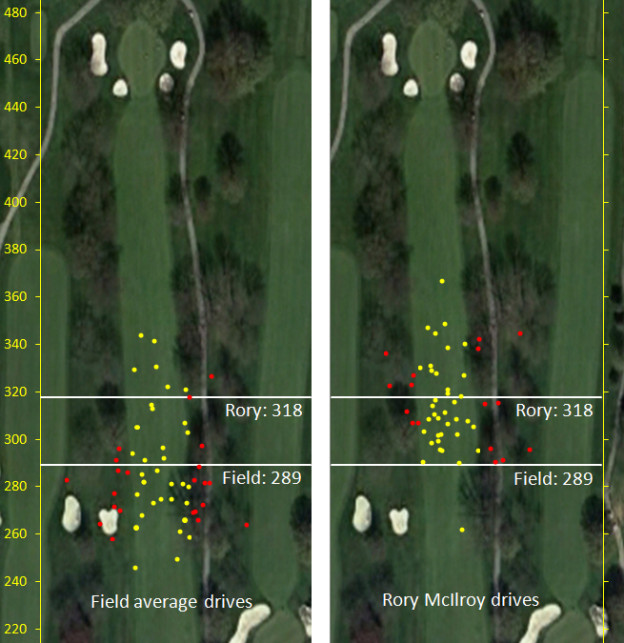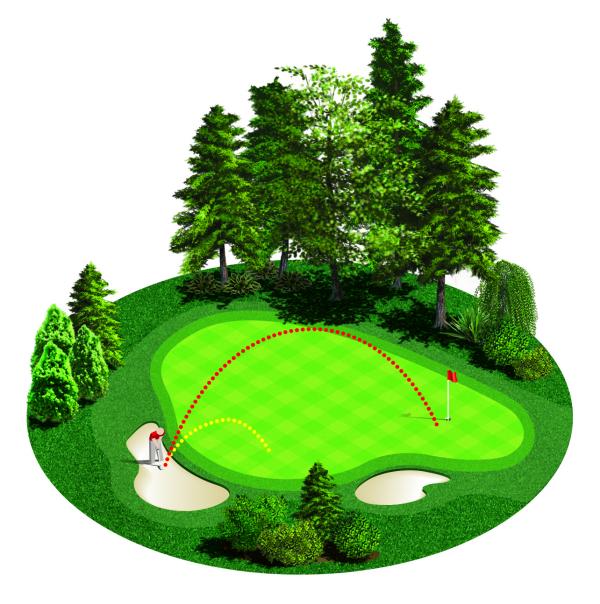Rory McIlroy’s win at the World Golf Championships-Bridgestone Invitational was powered by his driving. McIlroy gained an incredible 2.2 strokes per round on the field with his driver, which represents 53 percent of his total gain of 4.1 strokes per round for all of his shots.
Rory McIlroy’s driving performance is easier to appreciate with an illustration based on the PGA TOUR’s ShotLink data. For comparison, I found a player in the field whose strokes gained driving was zero and will call him the “field average” player. To visualize McIlroy’s drives and to compare with the field, I’ve overlayed all of the “field average” player’s drives (left panel) and all of McIlroy’s drives (right panel) in the tournament on the 13th hole at Firestone Country Club. A yellow dot indicates a drive that finished in the fairway or first cut. A red dot indicates a drive that missed the fairway and first cut. Note that “drives” are defined as tee shots on par-4 and par-5 holes, whether or not the player uses the driver. The difference between the “drive patterns” in the two panels is striking.
The field average driving distance was 289 yards. McIlroy’s tournament-leading average driving distance was nearly 30 yards further at 318 yards. The illustration shows that only one of McIlroy’s 56 drives travelled shorter than the field average distance.
The field’s drives found the fairway or first cut 62 percent of the time (35 out of 56 drives). McIlroy’s drives found the fairway or first cut 71 percent of the time (40 out of 56 drives). His longer and straighter drives gained a phenomenal 2.2 strokes per round on the field.
McIlroy’s strokes gained driving advantage can be understood by transforming the field average player’s drives into McIlroy’s drives. First, let’s take the field average player’s 35 drives that finished in the fairway and move them 30 yards closer to the hole, still in the fairway, to turn them into McIlroy’s drives. For example, suppose the drive of a player from the field left 170 yards to the green. McIlroy’s corresponding drive would leave him about 140 yards to the green. That’s a two- or three-club difference in the approach shot. TOUR golfers average about 0.12 fewer strokes to hole out from 170 than from 140. In fact, each of these 35 “moved” shots gains about 0.12 strokes, for a total gain of 4.2 strokes (0.12 times 35).
Second, let’s take 16 of the field average player’s drives that missed the fairway and move them 30 yards closer to the hole (but keeping them out of the fairway) to turn them into McIlroy’s drives. Each of these moves gains an average of 0.12 strokes, for a total gain of 1.9 strokes (0.12 times 16).
Third, let’s take 5 of the field average player’s drives that missed the fairway and move them 30 yards close to the hole and put them in the fairway. Each of these moves gains an average of 0.52 strokes, for a total gain of 2.6 strokes (0.52 times 5). (The gain is large because it includes a distance advantage and a direction advantage. The direction advantage also accounts for McIlroy hitting fewer drives into the sand and into penalty situations compared to the field.)
The total gain from these three sets of moves to turn “field average” drives into McIlroy’s drives is 8.7 strokes (4.2+1.9+2.6) for the tournament or about 2.2 strokes per round (8.7/4). McIlroy gained an average of 0.16 strokes per drive on the field (8.7/56) from his longer and straighter drives. While the fractional gains were relatively small for each of McIlroy’s drives, the cumulative gain over 56 drives in the tournament gave him a huge advantage on the field.
This post appeared originally on pgatour.com here


